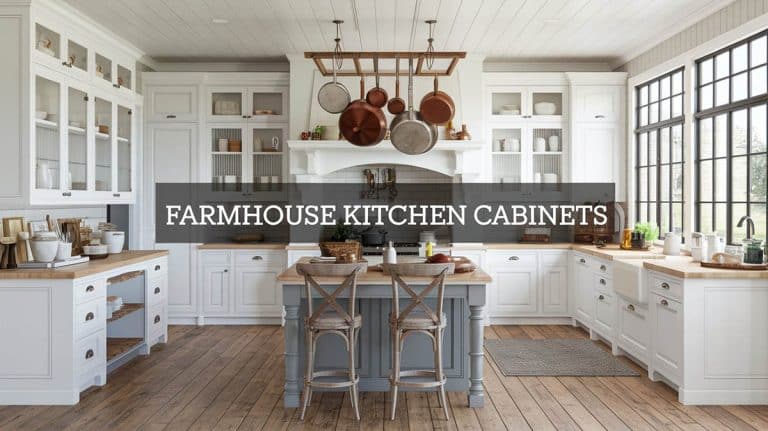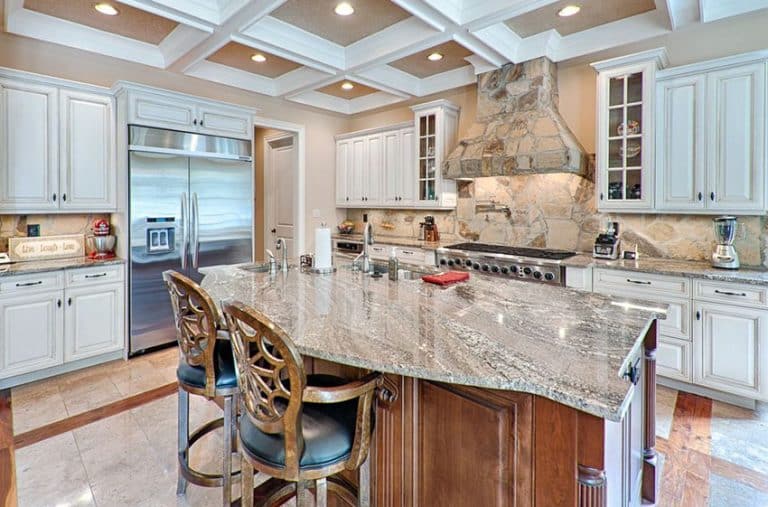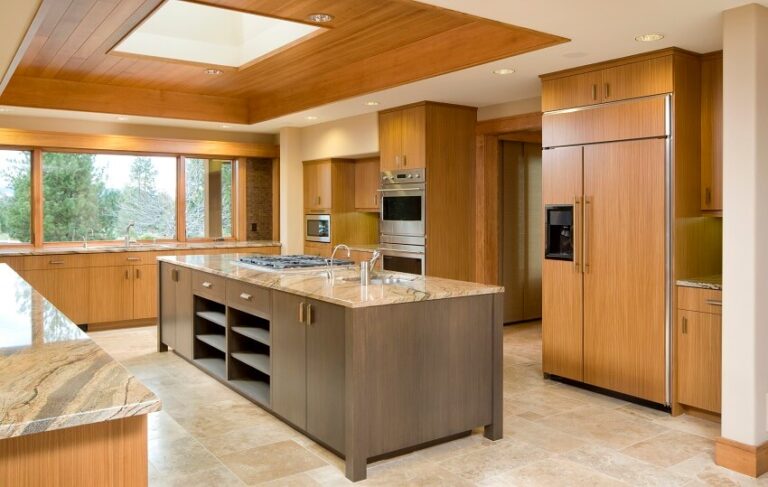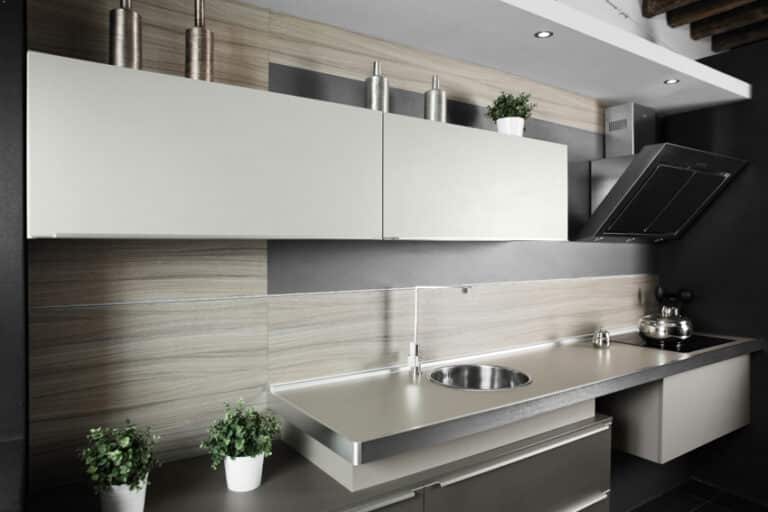Stacked Stone Backsplash (Designs & Benefits)
In this gallery of stacked stone backsplash designs you’ll find what it is, its benefits, how to choose, different stacked stone kitchen styles, and tips on grouting, sealing & cleaning.
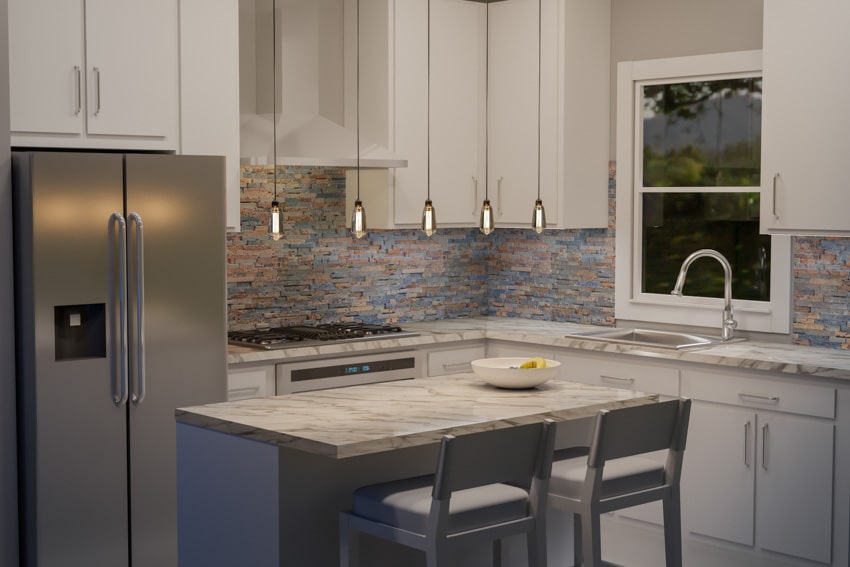
What Is A Stacked Stone Backsplash?
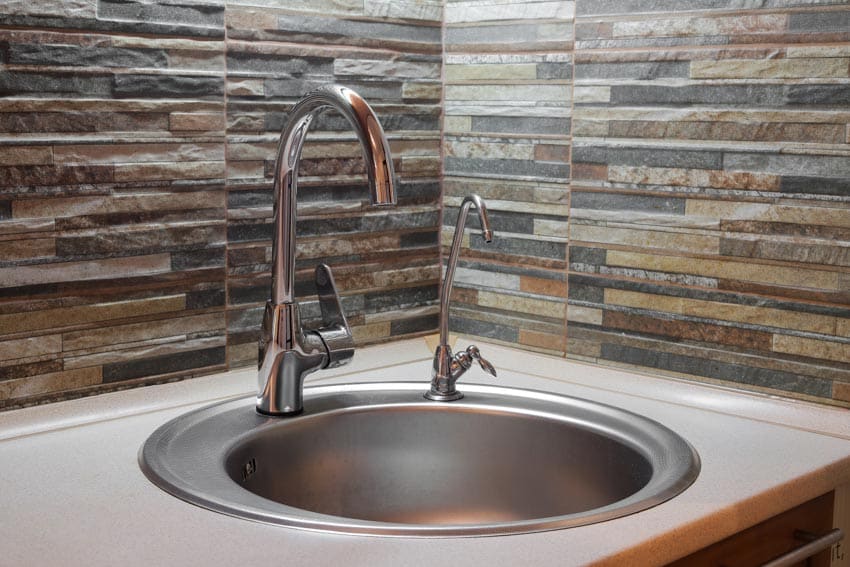
Stacked stone backsplash is a natural stone veneer that can be made from different types of stone, including slate, quartzite, marble, and granite.
The installation is comparable to tiling a wall, but there isn’t any grout involved. It is usually applied to vertical surfaces like walls, cladding, columns, and backsplashes and can be used for both interior and exterior applications. Stacked stone is also used to highlight any feature in your home.

Stacked stone backsplashes add a rustic, natural look to any kitchen. They are easy to clean and maintain and can last for years with proper care. Stacked stone backsplashes can be installed in a variety of ways, such as with grout or adhesive, and can be customized to fit any size or shape of kitchen.
Benefits Of Stacked Stone Backsplash
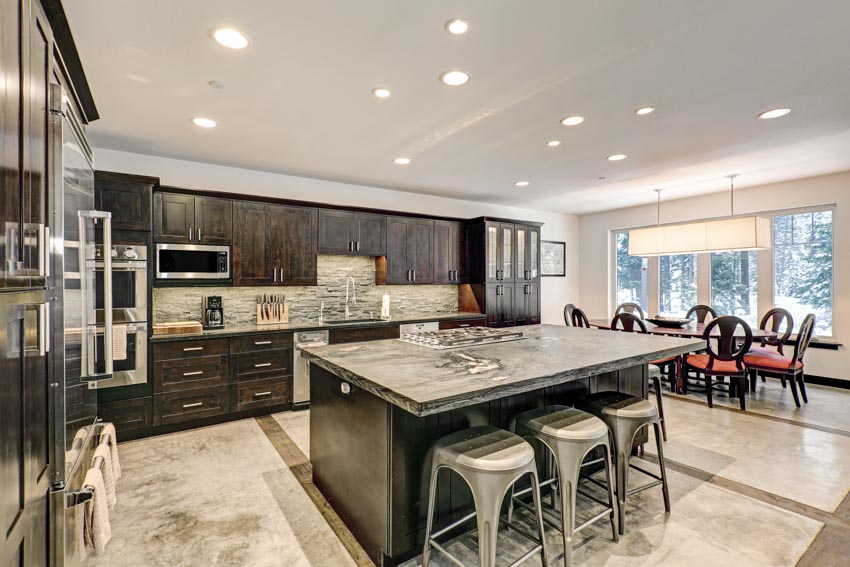
• Beauty: Stacked stone backsplashes add a beautiful, natural look to any kitchen or bathroom. They come in a variety of colors, shapes, and sizes to match any design style.
• Low Maintenance: Stacked stone backsplashes are easy to clean and maintain. All they need is a regular wipe-down with a damp cloth.
• Versatility: Stacked stone backsplashes can be used in a variety of ways. They can be used to add texture, color, and interest to a backsplash or used to create a focal point in a room. It can be used in different interior design styles whether traditional, contemporary or modern.
• Cost: A stacked stone backsplash is usually less expensive than other types of backsplashes, making it a great choice for those on a budget.
Choosing Your Stacked Stone Backsplash
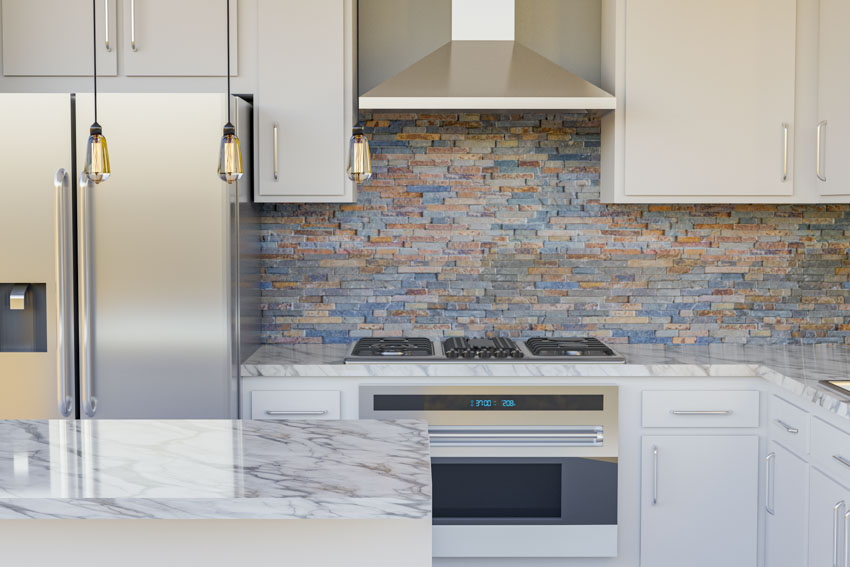
Depending on the kind of stone you choose, stacked stone might have a natural or polished appearance. For modern types of kitchen backsplash designs which require a seamless, clean and polished look, opt for harder materials, such as quartzite or granite, which should be utilized.
While for traditional, farmhouse, or country kitchen backsplashes, lean towards a more rustic aesthetic, and select softer stones because they are more suited for a natural finish.
Stack Stone Kitchen Backsplash Designs

Stacked Stone Tile Backsplash

Stacked stone tile has a fixed size of 24 x 6 inches and a thickness of 1 inch to 2.5 inches. It comes in a wide variety of colors and types of stones like travertine, slate, limestone, etc. You can find them readily available from local stone suppliers and even online.
Because of their fixed size, stacked stone tiles are easier and faster to install. It is typically attached to a wall using thinset mortar. The wide variety of stacked stone tiles makes it a versatile option for kitchen backsplashes.
For modern designs, stick with stacked stone tiles that have a clean look and a neutral palette, while for traditional backsplashes, opt for tiles that have a more rustic appearance.
Dry Stack Stone Backsplash
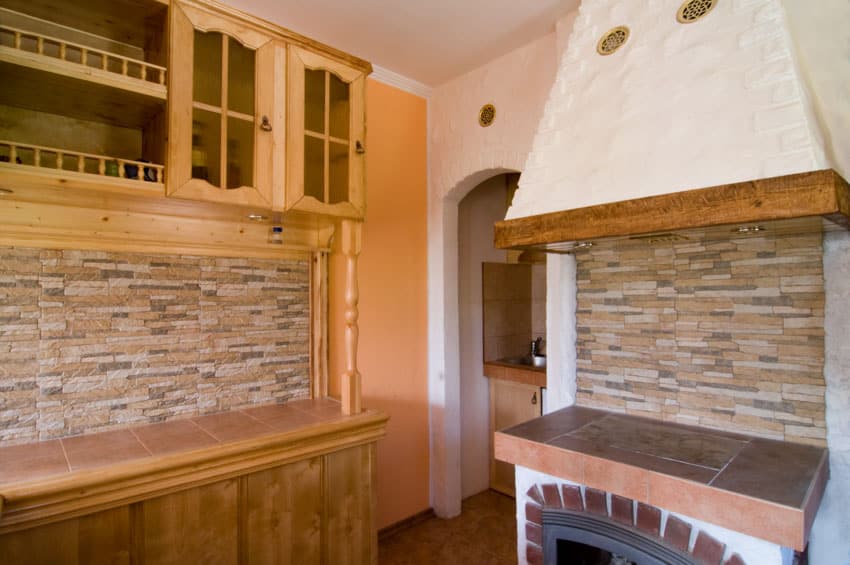
The stones used for dry stack stone backsplashes come in a variety of colors and textures, giving you the opportunity to customize the look of your kitchen.
The stones are typically cut in uniform shapes and sizes and are available in a variety of colors and finishes, allowing for a range of design possibilities.
Faux Stacked Stone Backsplash
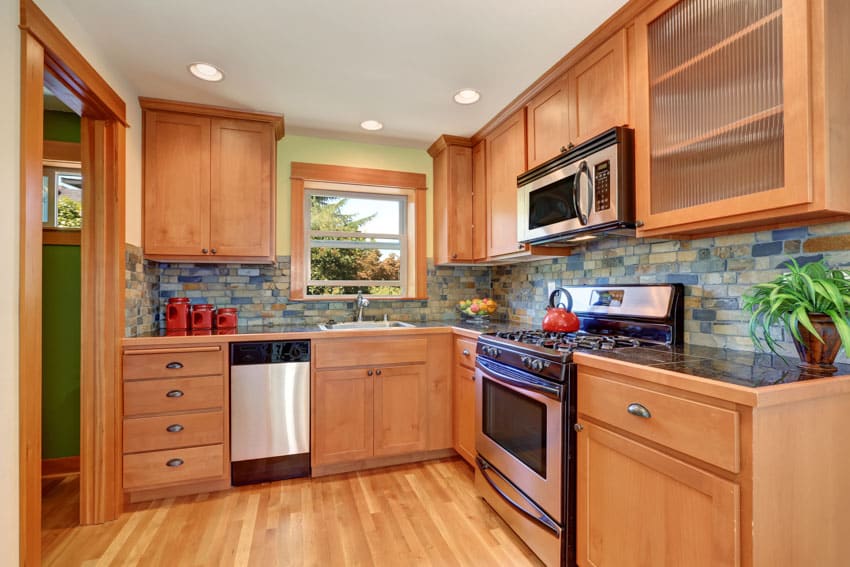
Faux stacked stone is often used for fireplaces, walls, and other home decor applications like backsplashes. Faux stacked stone can either come in tile, veneer, or peel and stick form. They are a much cheaper option for kitchen backsplashes but give off the same warmth of natural stone.
Stack Stone Veneer Backsplash
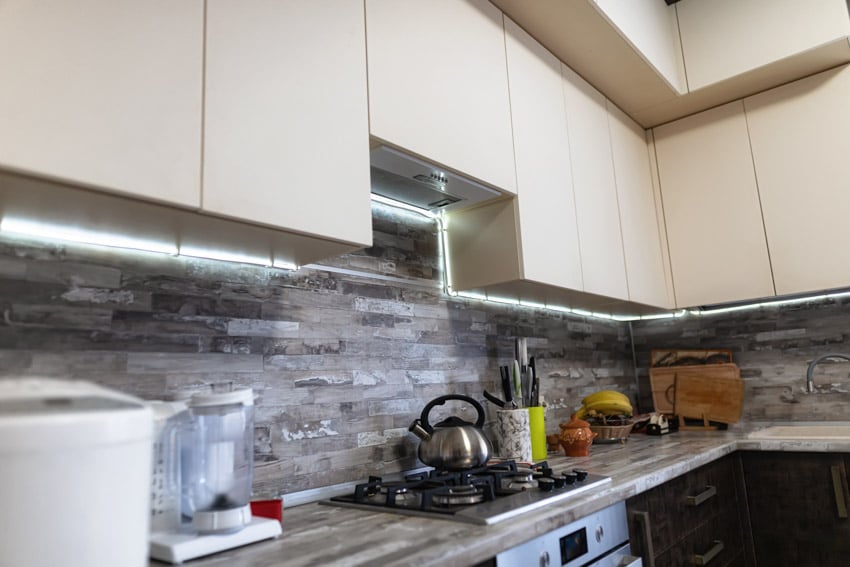
Stacked stone veneer is usually made from sandstone, quartzite, slate, or other types of natural stone attached to a backing. It is usually used to create the look of a traditional stone wall without the need for the depth and weight of full stone walls.
Stacked stone veneer backsplashes are thinner than their tile counterparts, but it is installed in the same way. It uses no grout but is very durable and long-lasting. It can be used for full backsplash designs or as an accent piece behind the stove with great results.
Stacked Stone Panels For Backsplash

These panels are very versatile and can be cut into any desired size, making them a more economical alternative to tile backsplashes. They are also quicker and easier to install compared to dry stacking each piece of stone one by one.
However, stacked stone panels can be quite heavy depending on the material used. The weight of the stacked stone prevents it from adhering to the drywall directly. It won’t have adequate support for its weight.
You run the risk of having to deal with an expensive drywall issue even if it first goes up and looks beautiful since the stone panels could pull the wall down due to its weight. So, if you are using this as a backsplash material, make sure to adhere it to a concrete wall or directly to wood studs.
If you are installing these panels in a wet area such as a bathroom or right behind the sink it’s advised to use a cement backerboard. These can be attached directly to wood studs to help act as a moisture barrier.
Peel And Stick Stacked Stone Backsplash

What is peel and stick stacked stone? Peel and stick stacked stone are a type of wall covering that uses individual pieces of faux stone that are pre-adhered to a backing material that can be peeled and applied directly to the wall, creating a realistic three-dimensional stone look.
This type of wall covering can be used to create a variety of finishes and textures, making it a popular decorative option for both interior and exterior walls. A peel and stick backsplash with a stacked stone design is an easy and affordable way to give your kitchen or bathroom a modern and stylish look.
This type of backsplash is made up of individual tiles that have a textured stone look and feel, and they come in a variety of colors and finishes to match any decor.
The tiles are easy to install, as all you must do is peel the backing off and stick them onto the wall. The adhesive backing makes them extremely durable and will last for years to come.
Grouting Stacked Stone Backsplash
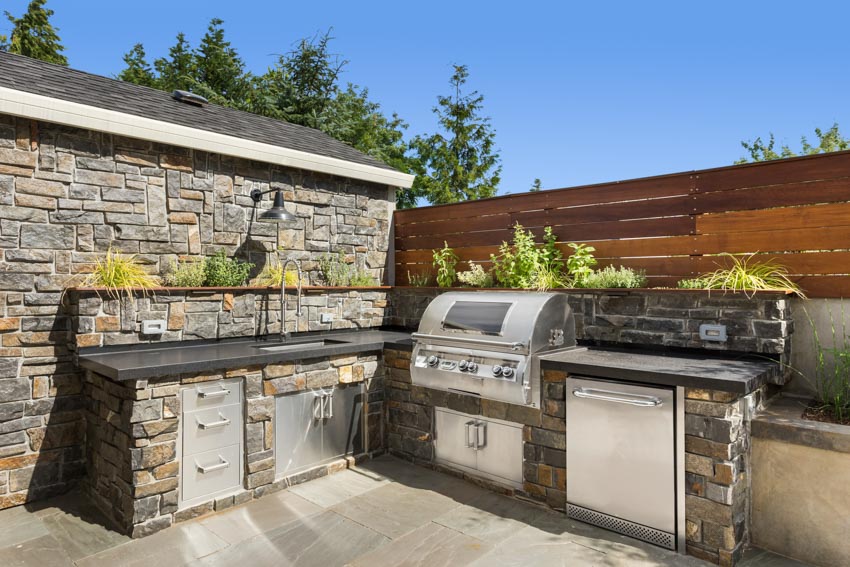
Wet laid stone on the other hand is a technique of laying irregular shaped stones on top of each other and filling in the gaps with mortar. For most modern applications a stacked stone tile panel or dry stack method is used.
During installation, just make sure that there are very minimal to no gaps in between panels, while for the veneer type, the outcome should be seamless.
How To Seal Stacked Stone Backsplash
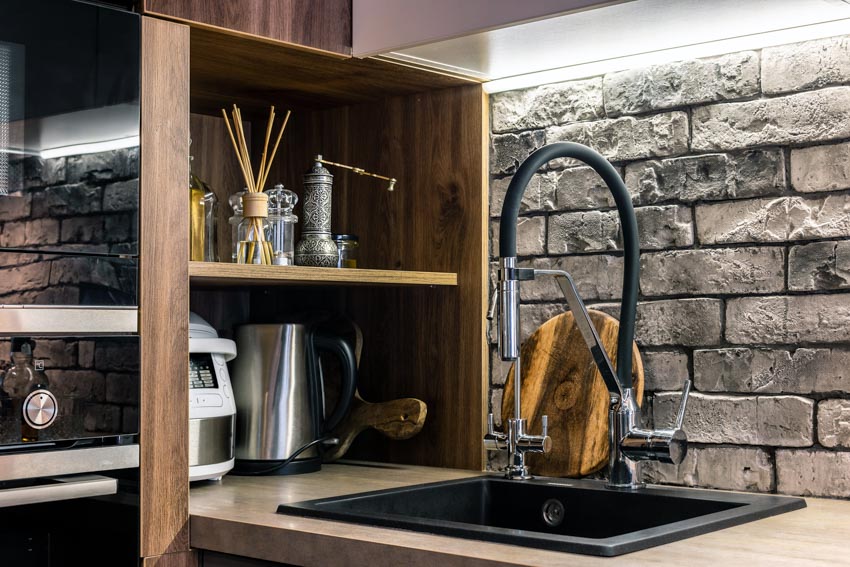
Below are some of the steps on how to seal a stacked stone backsplash.
1. Clean the surface of the stacked stone backsplash with a damp cloth. Allow the surface to dry completely.
2. Apply a thin, even layer of sealant to the backsplash using a paintbrush or a roller. Allow the sealant to dry according to the manufacturer’s instructions.
3. Apply a second thin, even layer of sealant to the backsplash, working from one side of the wall to the other. Allow the sealant to dry completely.
4. Buff the stacked stone backsplash with a soft cloth to remove any excess sealant.
5. Enjoy your newly sealed stacked stone backsplash.
How To Clean Stacked Stone Backsplash
Stacked stone backsplashes are easy to clean and do not require special tools to keep them looking their best. Below are the steps on how clean a stacked stone backsplash.
1. Before cleaning your stacked stone backsplash, start by dusting the surface with a soft cloth or broom.
2. Fill a bucket with warm water and a few drops of mild dish soap.
3. Dip a soft cloth or sponge in the soapy water and begin to clean the surface of the backsplash.
4. For tougher stains, create a paste with baking soda and a few drops of water. Apply the paste to the stain and gently scrub with a damp rag.
5. Rinse the backsplash with clean water and dry with a soft cloth.
6. If desired, apply a stone cleaner/sealer to give the surface a polished look.
Maintaining Stacked Stone Backsplash

1. Clean the surface of the backsplash regularly: To keep the stone backsplash looking its best, it’s important to clean the surface regularly.
Use a soft cloth and warm water to remove any dirt or dust that has collected on the stone. To remove any stubborn dirt or grime, use a mild detergent solution or a stone-specific cleaning product
2. Seal the backsplash: Sealing the stacked stone backsplash will help protect it from staining and discoloration. Use a stone sealant specifically designed for your type of stone and follow the instructions on the product label.
3. Handle spills immediately: Spills should be wiped up immediately to prevent staining. Use a clean, dry cloth to blot the surface, and then use a mild, pH-neutral cleaner to clean the area.
4. Use mild cleaning products: To keep the stone backsplash looking its best, use only mild, pH-neutral cleaning products. Harsh chemicals and abrasives can damage the stone and cause discoloration.
5. Avoid using harsh scrubbing tools: Scrubbing the backsplash with steel wool or abrasive pads can scratch the surface of the stone and cause discoloration.
See more related content in our article about matching countertops with backsplash on this page.

